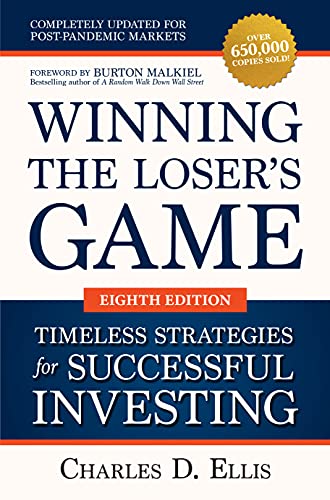Written by Charles D. Ellis, Winning the Loser’s Game – Timeless Strategies for Successful Investing is one of the most famous investment books ever written. Ellis founded Greenwich Associates, an international strategy consulting firm, and is an advocate of the passive investing style.
The book was on my reading list for almost a decade before I finally managed to read it, and it was pretty much what I expected it to be.
This one is a bit different from the other summaries I’ve written. In fact, this post only consists of two main ideas that, in my opinion, summarize the book well enough.
There is, of course, a lot of other important content about financial markets, investment management, and investing overall, but these two make up most of the book.
The first one is all about how hard it is to beat the market, and the second one is about indexing.
Beating the Market Is Extremely Difficult
Why exactly is the market so tough to beat?
When we consider investors like Benjamin Graham, Peter Lynch, and Warren Buffett, they made their fortunes back in the day when it was a lot easier to gain an informational edge.
Nowadays, an individual investor is extremely unlikely to gain such an edge since all the information out there is available to everyone, and the competition for information is fierce.
There are also a lot more analysts than there were back in the day. In fact, 60 years ago, there really weren’t any analysts to begin with. Nowadays, there are over 190,000 certified financial analysts worldwide.
Not to mention there are a lot more individual and institutional investors out there than there used to be. Furthermore, over 90% of the trades are done by either professionals or computers.
Overall, it’s safe to say that the nature of the market has changed, and not in the favour of an individual investor.
Can Professionals Beat the Market
Since it’s so difficult for individual investors to beat the market, how about professional fund managers?
Well, as Ellis points out, it’s even worse for active managers. After all the expenses, taxes, hidden costs, and whatnot, an overwhelming majority of professional fund managers fail to overcome operating costs and beat the market.
This is not because fund managers lack skill, it’s just the opposite. Nowadays, fund managers and their teams are so immensely skillful that it’s hard to do better than other equally skilled professionals.
There are, of course, investment professionals who consistently beat the market. The problem is that they’re extremely rare. since most fund managers who do well in a certain period of time fail to remain successful later on, picking the right funds and fund managers is a difficult task.
It’s also worth remembering that investment managers need to balance between doing what’s best for their client as well as what’s best for the managers themselves.
Therefore, according to Ellis (and statistics), investors would be better off putting their money in low-cost index funds instead of actively managed mutual funds.
Indexing Is Your Advantage
You know what they say: If you can’t beat ‘em, join ‘em.
There’s a way for an individual investor to achieve superior results with minimal effort, and that’s indexing.
As Ellis demonstrates in his book, the odds are not in your favour as an individual stock-picker or a professional fund manager. Investing actively in individual stocks is, in general, a loser’s game.
Therefore, the simplest way to achieve investing success is to invest regularly in a widely diversified index fund and hold your investments for a long time.
So, the way to beat the loser’s game is simply not to play it!
10 “Commandments” for an Individual Investor
Ellis also listed the 10 most important things every individual investor needs. I Decided to include the list in this post because I found it extremely helpful.
1) Learn how to save and invest your savings.
2) If you must “play the market”, do it with a small portion of your portfolio, not all of it.
3) Don’t do anything in investing purely for tax purposes and have a comprehensive estate plan.
4) Don’t think of your home as an investment.
5) Don’t invest in commodities.
6) Don’t get confused by stockbrokers and mutual funds salespeople – their job isn’t to make money for you but from you.
7) Don’t invest in novel or unusual kinds of investments – they are invented to be sold, not the be invested in.
8) Don’t invest in bonds if you’re truly a long-term investor – they make a poor inflation hedge.
9) Write out your long-term investing goals, program, and your estate plan – and follow them.
10) Don’t trust your feelings and aim to do as little as possible to avoid mistakes due to emotional upheavals.
Conclusions
As you can see, this summary is a bit on the short side. This is simply because the main message of the book is that clear. There are, obviously, a lot of important things in the book that aren’t covered in this post, which is why I highly recommend you read it.
However, I do feel there are a couple of things I’d like to point out.
As I read the book, I started to feel like investing in individual stocks is completely hopeless, and the only proper way to get satisfying returns is through indexing.
For me and a lot of other investors, holding a focused portfolio of winning individual stocks for a long time is still the best investment strategy on the planet.
This is not to say that it’s easy to pick and hold those winning stocks, but I do firmly believe it can be done with a skillful analysis and a disciplined mind.
I completely agree with Ellis that most investors, especially beginner investors, will do better by investing passively in index funds. For most people, it truly is the best way to get guaranteed results.
Nevertheless, Winning the Loser’s Game is a must-read for all long-term stock investors, especially for beginners.




